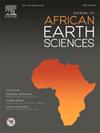Palaeontological and palaeoenvironmental study of Coniacian–Santonian bivalves (Upper Cretaceous) from Cap Estérias in the northern Gabon coastal basin
IF 2.2
4区 地球科学
Q2 GEOSCIENCES, MULTIDISCIPLINARY
引用次数: 0
Abstract
A study of Coniacian-Santonian bivalves (Upper Cretaceous) was conducted in three stratigraphic sections from the northern part of the Gabon coastal basin, specifically located at Cap Estérias in the Akanda commune. Thirteen species, belonging to ten genera and seven families, were identified. Among these taxa, three genera — Cataceramus Heinz, Rhyssomytiloides Hessel and Sergipia Maury— and twelve species: Arca cf. ligeriensis d'Orbigny, ? Cataceramus barabini Morton, Cataceramus sp., Cyprina sp. 1, Cyprina sp. 2, Fragum subperobliquum (Riedel), ? Fragum sp., Lima (Plagiostoma) sp., Pleuromya ligeriensis (d’Orbigny), Rhyssomytiloides cf. retirensis Hessel, Rhyssomytiloides sp., Sergipia cf. posidonomyaformis (Maury) and Venericardia cf. crossensis Reyment, were characterised and illustrated for the first time in the Gabon coastal basin. The newly recorded taxa from this study extend the known geographical distribution of these species to Gabon. The bivalve assemblage, dominated by epifaunal form, suggests a high-energy marine environment; However, the presence of infaunal species also indicates the existence of a moderately soft substrate.
加蓬北部沿海盆地estamesrias盖的上白垩世coniian - santonian双壳类古生物学和古环境研究
在加蓬海岸盆地北部,特别是位于Akanda公社的Cap estamesrias的三个地层剖面上,对coniian - santonian双壳类(上白垩纪)进行了研究。经鉴定,属7科10属13种。在这些分类群中,有3个属,分别是:海氏龙属、海塞尔龙属和毛利龙属;12个种,分别是:奥比尼龙属、奥比尼龙属、奥比尼龙属。barabini Morton, Cataceramus sp., Cyprina sp. 1, Cyprina sp. 2, Fragum subperobliquum (Riedel), ?Fragum sp.、Lima (Plagiostoma) sp.、Pleuromya ligeriensis (d 'Orbigny)、Rhyssomytiloides cf. retirensis Hessel、Rhyssomytiloides sp.、Sergipia cf. possidonomyformis (Maury)和Venericardia cf. crossensis resion首次在加蓬沿海盆地进行了鉴定。这项研究新记录的分类群将这些物种的已知地理分布扩展到加蓬。双壳类组合以脚底形态为主,表明其为高能海洋环境;然而,动物物种的存在也表明存在适度柔软的基质。
本文章由计算机程序翻译,如有差异,请以英文原文为准。
求助全文
约1分钟内获得全文
求助全文
来源期刊

Journal of African Earth Sciences
地学-地球科学综合
CiteScore
4.70
自引率
4.30%
发文量
240
审稿时长
12 months
期刊介绍:
The Journal of African Earth Sciences sees itself as the prime geological journal for all aspects of the Earth Sciences about the African plate. Papers dealing with peripheral areas are welcome if they demonstrate a tight link with Africa.
The Journal publishes high quality, peer-reviewed scientific papers. It is devoted primarily to research papers but short communications relating to new developments of broad interest, reviews and book reviews will also be considered. Papers must have international appeal and should present work of more regional than local significance and dealing with well identified and justified scientific questions. Specialised technical papers, analytical or exploration reports must be avoided. Papers on applied geology should preferably be linked to such core disciplines and must be addressed to a more general geoscientific audience.
 求助内容:
求助内容: 应助结果提醒方式:
应助结果提醒方式:


